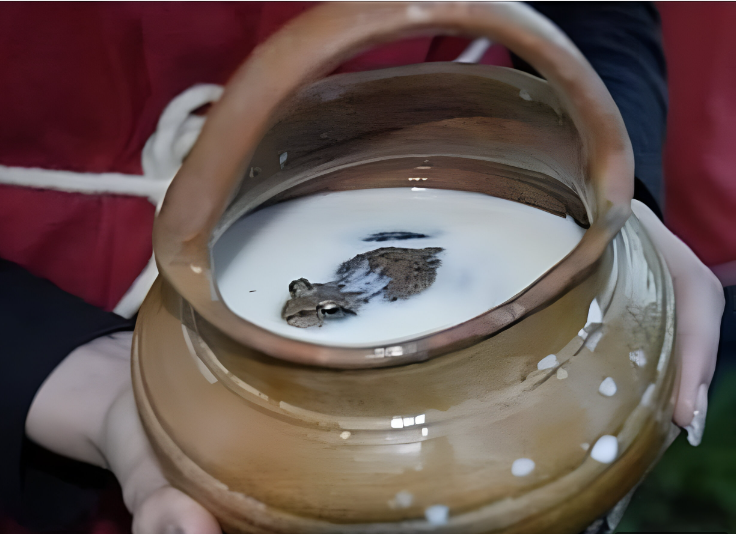The idea of placing a frog in milk to keep it fresh sounds unusual, even a bit unsettling, but it’s rooted in a fascinating piece of folklore. Originating from Russian peasant traditions, this belief finds surprising support in modern scientific research. Let’s dive into the science, history, and cultural significance behind this folk remedy.
The Science Behind the Frog’s “Preservative Powers”
In 2012, scientists in Moscow identified 76 peptides in the secretions of Rana temporaria, a species commonly known as the European common frog. Many of these peptides possess antibacterial properties, which means they can inhibit the growth of certain types of bacteria. Given the global issue of antibiotic resistance, the discovery made headlines, drawing attention to potential medicinal applications. However, it also stirred interest for another reason: the study seemed to validate an old Russian folk belief about using frogs to preserve milk.
These findings align with a possible explanation for the folk practice. If frogs release antibacterial substances, placing a frog in milk might indeed help slow down bacterial growth. But before leaping to conclusions, it’s essential to note that modern researchers don’t actually recommend adding frogs to milk. Instead, they study the compounds the frogs secrete, which might someday be used in preservation or medicine.
Food Preservation in the Pre-Refrigeration Era
In centuries past, preserving milk was a challenge. Even in cold climates like Russia’s, milk would spoil quickly without refrigeration. Farmers and peasants relied on methods like cellars, salting, and fermenting to preserve food, but milk remained tricky to keep fresh. Since bacteria multiply rapidly at room temperature, milk would often turn sour within a day or two, and spoiled milk could be risky to drink.
While we may not fully understand the original reasoning behind this tradition, a frog’s naturally cool, clammy feel could have inspired a belief in its preserving qualities. Another thought is that people might have associated the frog’s “cold” nature with milk’s need to stay cool.
Frogs in Russian Folklore and Milk Tales
The folk tradition of putting frogs in milk was not isolated to a single tale. In Russian culture, frogs symbolize endurance, transformation, and even good fortune in various stories. For example, one tale involves two frogs falling into a milk can. While one frog loses hope and drowns, the other keeps swimming vigorously until the milk churns into butter, allowing the frog to escape. This story, while not directly about preservation, links frogs with milk in an enduring way.
There is also the figure of Babushka-Lyagushka-Shakusha, a mystical “Grandmother Hopping Frog,” who swims in a milk bath. Such figures add a touch of magic to the story, blending folklore with real-life experience. The tales of frogs in milk aren’t unique to Russia, either; similar accounts exist in other cultures, suggesting a widespread belief in the connection between frogs and freshness.
Historical Accounts: Frogs in the Milk by Accident?
One intriguing clue about the origins of this folk belief comes from an 1854 New York Times letter to the editor. A farmer described how he would often submerge his milk cans in a cold spring to keep the milk cool, only to find that frogs sometimes found their way in. After fishing them out, he noted, the milk was still drinkable. While this method wasn’t foolproof, it might have influenced people’s perceptions—over time, farmers and milkmaids might have come to believe that the frogs helped preserve the milk, whether they actually did or not.
The Cultural Legacy of Frog Preservation Myths
The story of using frogs to keep milk fresh may seem bizarre today, but it reminds us of how ancient wisdom often combined practical experience with superstition. While modern science shows that certain frog secretions can indeed be antibacterial, it’s unlikely that Russian peasants fully understood this chemistry. Instead, they turned to nature’s helpers, combining empirical observations with a bit of magical thinking.
In the end, the belief may have arisen simply because frogs often found their way into milk in the first place. But through the eyes of folklore, the amphibian’s presence turned from nuisance to potential benefit, creating a lasting cultural narrative.
So, can a frog keep milk from going bad? Science suggests there may be a kernel of truth, at least at a molecular level. However, practical milk preservation in the modern day involves proper refrigeration rather than amphibious additives. Nevertheless, the story captures the imagination, blending science, history, and culture in a way that makes even a quirky old folk remedy seem almost plausible.







